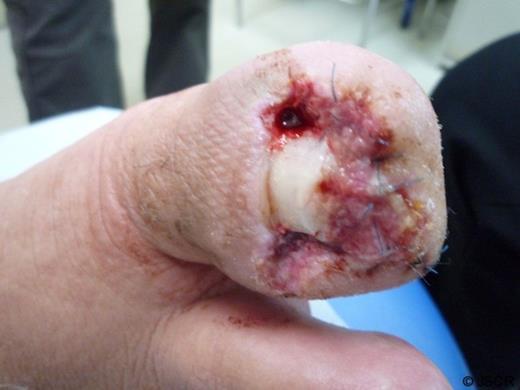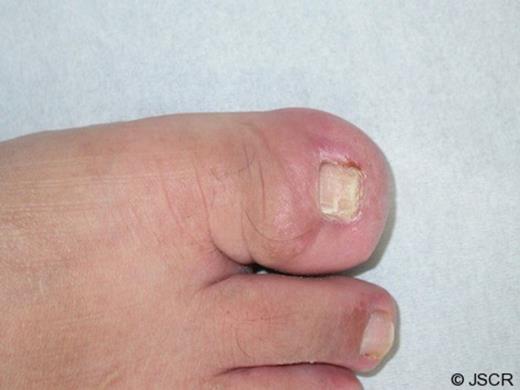-
PDF
- Split View
-
Views
-
Cite
Cite
A Sugamata, N Yoshizawa, A strange case of ingrown toenail treated with phenol, Journal of Surgical Case Reports, Volume 2011, Issue 7, July 2011, Page 5, https://doi.org/10.1093/jscr/2011.7.5
Close - Share Icon Share
Abstract
We experienced a strange case of ingrown toenail, which had developed as a huge mass and enveloped the nail of the left first toe. The patient had self-treated his ingrown toenail for a period of one year with an ointment available over the counter. However, the granulation tissue on both sides of the nail had increased gradually and advanced over the nail plate in the medial direction. Finally, the granulation tissue on both sides had adhered to the nail and epithelial cells advanced over the granulation tissue completely. During surgery, the epithelized granulation tissue was excised at the bilateral terminal base point, and the posterior nail fold and the nail matrix were cauterized completely with phenol. Eighteen months after the operation there was no recurrence of the ingrown toenail.
INTRODUCTION
The ingrown toenail is a common problem which occurs mostly in the first toe and causes a high amount of morbidity in affected patients. In this report we document a strange case of ingrown toenail of the first toe, which had developed as a huge mass and enveloped the nail. We describe here the cauterization of the nail matrix with phenol after surgical resection of the tumor, a treatment that had good results.
CASE REPORT
A 56-year-old man came to our office complaining of pain, offensive smelling discharge and disappearance of the nail of the right great toe. Physical examination showed epithelized mass on the nail plate and fistulation from the proximal nail fold to the tip of the toe, epithelization did not occur on the nail plate side of the mass (Figure 1). The clinical diagnosis of this tumor was epithelized granulation tissue caused by ingrown toenail, however squamous cell carcinoma was not denied completely.

The first toe of a 56-year-old man. Photograph shows epithelized granulation tissue on the nail plate and fistulation from the proximal nail fold to the tip of the toe
The operative treatment involved anesthetizing the toe with a digital nerve block using 1% lignocaine. The tumor mass was excised at the bilateral terminal base point, and was sent to pathology for an immediate diagnosis. The pathological finding was granulation tissue with partial scar formation, and the external surface of the tumor was covered with epithelial cells. Next, the nail plate was incised longitudinally from top to the root at a width of approximately 5mm. The posterior nail fold and the nail matrix were cauterized completely with an 88% phenol-immersed cotton-tipped applicator for five minutes. The excessive skin and soft tissue of the tip of the toe were excised and trimmed (Figure 2).

Bilateral chemical matricectomy of the matrix was done with phenol after resection of the tumor
Eighteen months after the operation, there is no recurrence of the ingrown toenail (Figure 3).

Eighteen months after the operation there was no recurrence of the ingrown toenail
DISCUSSION
Ingrown toenail deformity is a common nail pathology that causes intractable pain and discomfort, hindering normal walking and markedly decreasing the quality of life of patients. Ingrown toenails could be a cause of granulation tissue of the lateral nail fold of the finger or toe (1). However, an ingrown toenail creating such a huge mass on the nail plate, as in this case, is very rare. In the literature, to our knowledge, there have been no reports of cases similar to our patient.
In the case presented here, the patient had treated his ingrown toenail himself for one year with an ointment purchased over the counter before he came to our office. However the granulation tissue of both sides of the nail had increased gradually and advanced on the nail plate in the medial direction. Finally, the granulation tissue from both sides adhered and epithelial cells advanced over the granulation tissue completely. We believe such pathogenesis of this tumor is very uncommon.
Conservative and surgical forms of therapy for ingrown nails have been used, however, there is no common or unique form of treatment (2,–,6). In recent years, matrix phenolization of the nail bed has been used increasingly, and has been reported to give less discomfort and lower recurrence rates (7,8). The procedure of phenolization is easy to perform and does not require specialized equipment (9). In our reported case, after resection of the epithelized granuloma, both sides of the posterior nail fold and the nail matrix were cauterized completely with phenol. After this simple treatment, there was no recurrence of the ingrown toenail. The only disadvantage of the treatment was the smallness of the toenail, however, the patient did not complain of this aesthetic disadvantage due to the advantages of freedom from pain and the bad odour.



